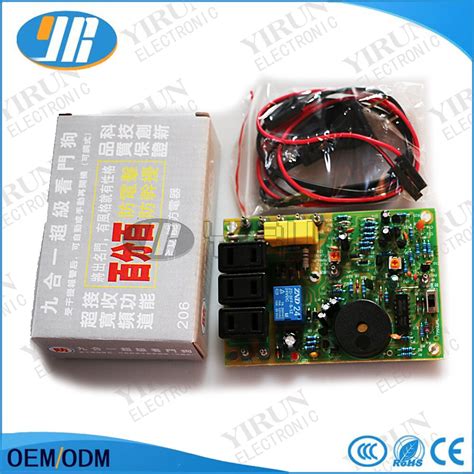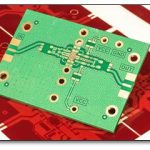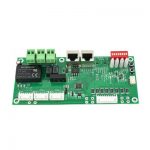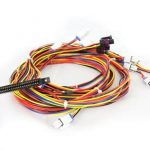Introduction to PCB Anti-interference
Printed Circuit Boards (PCBs) are the backbone of modern electronic devices. They provide a platform for mounting and interconnecting electronic components to form a complete circuit. However, as the density and complexity of PCBs increase, so do the challenges related to electromagnetic interference (EMI) and radio frequency interference (RFI). These interferences can lead to signal integrity issues, crosstalk, and even complete circuit failure. Therefore, it is crucial to implement effective anti-interference methods in PCB design and manufacturing.
In this article, we will explore various techniques and strategies to mitigate interference in PCB circuits. We will cover topics such as grounding, shielding, filtering, component placement, and more. By understanding and applying these anti-interference methods, designers can create PCBs that are more robust, reliable, and resistant to external and internal disturbances.
Understanding Interference in PCBs
Before diving into the anti-interference methods, let’s first understand what causes interference in PCBs and how it affects circuit performance.
Sources of Interference
Interference in PCBs can originate from various sources, both internal and external to the circuit. Some common sources of interference include:
-
Electromagnetic Interference (EMI): EMI is caused by the unintentional emission of electromagnetic energy from electronic devices. It can be generated by switching power supplies, high-speed digital circuits, motors, and other sources.
-
Radio Frequency Interference (RFI): RFI is a type of EMI that specifically refers to interference in the radio frequency spectrum. It can be caused by wireless communication devices, such as mobile phones, Wi-Fi routers, and Bluetooth devices.
-
Crosstalk: Crosstalk occurs when signals from one circuit or trace inadvertently couple with adjacent circuits or traces. It is more prevalent in high-speed and high-frequency circuits.
-
Power Supply Noise: Noise generated by power supplies, such as voltage ripples and spikes, can propagate through the power distribution network and affect sensitive circuits.
-
Environmental Factors: External factors like temperature variations, humidity, vibrations, and electrostatic discharge (ESD) can also contribute to interference in PCBs.
Effects of Interference
Interference in PCBs can manifest in various ways, depending on the nature and severity of the disturbance. Some common effects of interference include:
-
Signal Integrity Issues: Interference can distort or corrupt signals, leading to data errors, jitter, and reduced signal-to-noise ratio (SNR).
-
Crosstalk: Unintended coupling between circuits can cause unwanted signals to appear on adjacent traces, leading to signal distortion and errors.
-
EMI Emissions: PCBs that generate excessive EMI can interfere with nearby electronic devices and violate regulatory standards.
-
Reduced Performance: Interference can degrade the overall performance of the PCB, causing slower data transmission, increased power consumption, and reduced reliability.
Grounding Techniques for PCB Anti-interference
Proper grounding is one of the most critical aspects of PCB design for minimizing interference. A well-designed grounding system helps to provide a low-impedance return path for signals, minimize ground loops, and reduce EMI emissions. Here are some grounding techniques to consider:
Ground Planes
Using a solid ground plane is an effective way to provide a low-impedance return path for signals. A ground plane acts as a reference for all signals and helps to minimize the loop area, which reduces EMI emissions. It also provides shielding against external interference.
When designing a ground plane, consider the following:
– Use a continuous ground plane whenever possible, especially for high-speed circuits.
– Avoid splitting the ground plane unnecessarily, as it can create discontinuities and increase impedance.
– Connect all ground points to the ground plane using low-impedance connections, such as vias or wide traces.
Star Grounding
Star grounding is a technique where all ground connections are made to a single point, known as the star point. This approach helps to minimize ground loops and reduce noise coupling between different sections of the PCB.
In a star grounding system:
– Each subsystem or module has its own local ground, which is connected to the star point through a low-impedance path.
– The star point is typically located near the power supply or the most sensitive part of the circuit.
– Avoid daisy-chaining ground connections, as it can create ground loops and increase noise coupling.
Chassis Grounding
Chassis grounding involves connecting the PCB ground to the metal chassis or enclosure of the device. This technique helps to provide a low-impedance path for EMI currents and shields the PCB from external interference.
When implementing chassis grounding:
– Use dedicated grounding points or pads on the PCB to connect to the chassis.
– Ensure a good electrical contact between the PCB ground and the chassis using conductive gaskets, screws, or clips.
– Avoid creating ground loops by ensuring that there is only one connection point between the PCB ground and the chassis.
Grounding for Mixed-Signal PCBs
Mixed-signal PCBs, which contain both analog and digital circuits, require special consideration for grounding to minimize noise coupling between the two domains.
Some grounding techniques for mixed-signal PCBs include:
– Separate analog and digital ground planes, connected at a single point near the power supply.
– Use a ground moat or split to isolate the analog and digital sections of the PCB.
– Route analog and digital signals on separate layers to minimize crosstalk.
– Use filters and ferrites to suppress high-frequency noise at the interface between analog and digital sections.

Shielding Techniques for PCB Anti-interference
Shielding is another effective method for reducing EMI and RFI in PCBs. Shielding involves enclosing sensitive circuits or components within a conductive barrier to attenuate electromagnetic fields. Here are some shielding techniques to consider:
Faraday Cages
A Faraday cage is a conductive enclosure that surrounds a circuit or component to shield it from external electromagnetic fields. It works by reflecting or absorbing incoming electromagnetic waves, preventing them from reaching the protected area.
When designing a Faraday cage:
– Use a conductive material, such as metal or conductive plastic, to form the enclosure.
– Ensure that the enclosure completely surrounds the protected area, with no gaps or openings.
– Connect the Faraday cage to the PCB ground using low-impedance connections, such as conductive gaskets or screws.
Shielding Cans
Shielding cans are preformed metal enclosures that can be placed over sensitive components or circuits on the PCB. They provide localized shielding against EMI and RFI, and are particularly useful for shielding high-frequency components, such as oscillators and radio modules.
When using shielding cans:
– Choose a can size that provides sufficient clearance for the components and allows for proper airflow.
– Ensure a good electrical contact between the can and the PCB ground using conductive adhesives, gaskets, or soldering.
– Consider the impact of the shielding can on the component’s thermal dissipation and make provisions for heat sinking if necessary.
Shielded Cables and Connectors
Using shielded cables and connectors is essential for preventing interference in interconnects between PCBs or between a PCB and external devices. Shielded cables have a conductive layer surrounding the signal wires, which helps to attenuate electromagnetic fields.
When using shielded cables and connectors:
– Choose cables with an appropriate shielding material and coverage, such as foil, braid, or both.
– Ensure that the shield is properly terminated at both ends of the cable, typically to the connector shell or a dedicated shield pin.
– Use connectors with conductive shells and EMI gaskets to maintain shield continuity.
PCB Layout Techniques for Shielding
Proper PCB layout can also contribute to effective shielding against interference. Some layout techniques to consider include:
– Placing sensitive circuits away from sources of interference, such as power supplies or high-speed digital circuits.
– Using ground planes and power planes to provide shielding between layers.
– Routing critical signals between ground or power planes to take advantage of their shielding effect.
– Using guard traces or guard rings around sensitive circuits to divert interference currents away from the protected area.
Filtering Techniques for PCB Anti-interference
Filtering is a technique used to suppress unwanted frequency components from signals, thus reducing interference. Filters can be implemented using passive components, such as capacitors, inductors, and resistors, or active components, such as op-amps and transistors. Here are some common filtering techniques used in PCBs:
Decoupling Capacitors
Decoupling capacitors are used to suppress high-frequency noise on power supply lines. They act as local energy reservoirs, providing a low-impedance path for high-frequency currents and preventing them from propagating throughout the PCB.
When using decoupling capacitors:
– Place them as close as possible to the power pins of the integrated circuits (ICs) they are decoupling.
– Use a combination of capacitors with different values to cover a wide frequency range, typically a larger capacitor (e.g., 10 µF) for low frequencies and a smaller capacitor (e.g., 0.1 µF) for high frequencies.
– Use low-equivalent series resistance (ESR) and low-equivalent series inductance (ESL) capacitors for better high-frequency performance.
Ferrite Beads
Ferrite beads are passive components that act as high-frequency resistors, suppressing high-frequency noise currents without affecting DC or low-frequency signals. They are often used in series with power supply lines or signal lines to filter out EMI.
When using ferrite beads:
– Choose a bead with an appropriate impedance and frequency characteristics for the specific application.
– Place the ferrite bead close to the noise source or the sensitive component being protected.
– Consider the DC resistance of the ferrite bead and ensure that it does not cause excessive voltage drop or power dissipation.
EMI Filters
EMI filters are designed to attenuate unwanted electromagnetic interference in a specific frequency range. They typically consist of a combination of capacitors and inductors, and can be configured as low-pass, high-pass, or band-pass filters depending on the application.
When using EMI filters:
– Choose a filter topology and component values that provide the desired attenuation and frequency response.
– Place the filter close to the noise source or the sensitive component being protected.
– Ensure proper grounding and shielding of the filter to prevent interference from bypassing the filter.
Power Supply Filtering
Power supply noise can be a significant source of interference in PCBs. In addition to decoupling capacitors, other filtering techniques can be used to reduce power supply noise:
– Use a pi-filter or LC filter at the power input to attenuate high-frequency noise from the external power source.
– Implement a power supply rejection ratio (PSRR) filter for sensitive analog circuits to reduce the impact of power supply noise on the signal chain.
– Use a voltage regulator with good noise rejection characteristics, such as a low-dropout (LDO) regulator, to provide a clean and stable power supply for sensitive circuits.
Component Placement and Layout Techniques for PCB Anti-interference
Proper component placement and PCB layout can significantly reduce interference and improve the overall performance of the circuit. Here are some techniques to consider:
Component Placement
- Place sensitive components, such as analog circuits or high-speed digital circuits, away from sources of interference, such as power supplies, motors, or high-current traces.
- Group components by function or by their sensitivity to interference, and separate them with ground planes or shielding.
- Place decoupling capacitors as close as possible to the power pins of the ICs they are decoupling.
- Orient components to minimize the loop area of critical signal paths, reducing the potential for EMI pickup.
Signal Routing
- Route critical signals, such as clock lines or high-speed data lines, away from sources of interference or noisy circuits.
- Use short and direct traces for critical signals to minimize the loop area and reduce the potential for EMI pickup.
- Avoid routing sensitive signals parallel to high-current or high-frequency traces to minimize crosstalk.
- Use stripline or microstrip techniques for high-frequency signals to control impedance and minimize radiation.
Power and Ground Distribution
- Use separate power and ground planes for analog and digital circuits to minimize noise coupling between the two domains.
- Implement a solid and continuous ground plane to provide a low-impedance return path for signals and minimize ground loops.
- Use wide and short traces for power distribution to minimize voltage drops and power supply noise.
- Place power and ground vias close to the component power pins to minimize the loop area and reduce inductance.
Layer Stackup
- Use a multi-layer PCB stackup with dedicated power and ground planes to provide shielding and reduce EMI.
- Alternate signal layers with power and ground planes to minimize crosstalk and provide a controlled impedance environment.
- Use a symmetrical stackup to balance copper distribution and minimize warpage.
- Consider using a high-speed material, such as Rogers or Isola, for high-frequency designs to reduce losses and improve signal integrity.
Testing and Verification of PCB Anti-interference Measures
After implementing anti-interference techniques in the PCB design, it is essential to test and verify their effectiveness. Here are some methods for testing and verifying PCB anti-interference measures:
EMI Testing
EMI testing involves measuring the electromagnetic emissions from the PCB and ensuring that they comply with relevant EMC standards, such as FCC Part 15, CISPR, or EN 55022. EMI testing can be performed in a certified EMC laboratory or using specialized equipment, such as a spectrum analyzer or an EMI receiver.
Some common EMI tests include:
– Radiated emissions testing: Measuring the electromagnetic fields emitted by the PCB at a specified distance.
– Conducted emissions testing: Measuring the noise currents on power supply lines or signal lines.
– Susceptibility testing: Exposing the PCB to external electromagnetic fields and verifying its immunity to interference.
Signal Integrity Testing
Signal integrity testing involves analyzing the quality of signals on the PCB and identifying any issues related to interference, crosstalk, or reflections. Signal integrity testing can be performed using an oscilloscope, a vector network analyzer (VNA), or specialized software tools.
Some common signal integrity tests include:
– Time-domain reflectometry (TDR): Measuring the impedance and reflections along a transmission line.
– Eye diagram analysis: Visualizing the quality of a digital signal and measuring parameters such as jitter, rise time, and noise margin.
– Crosstalk analysis: Measuring the coupling between adjacent signal traces and identifying potential sources of crosstalk.
Power Integrity Testing
Power integrity testing involves analyzing the quality of the power distribution network on the PCB and identifying any issues related to noise, ripple, or voltage drops. Power integrity testing can be performed using an oscilloscope, a power supply analyzer, or specialized software tools.
Some common power integrity tests include:
– Power supply noise measurement: Measuring the noise and ripple on power supply lines using an oscilloscope or a spectrum analyzer.
– Impedance analysis: Measuring the impedance of the power distribution network over a range of frequencies using a VNA or an impedance analyzer.
– Voltage drop analysis: Measuring the voltage drops along power supply traces and identifying potential issues related to insufficient copper width or excessive current density.
Functional Testing
Functional testing involves verifying that the PCB performs as intended under various operating conditions and in the presence of interference. Functional testing can be performed using the actual application or a test setup that simulates the intended environment.
Some aspects to consider during functional testing include:
– Testing the PCB under different temperature, humidity, and vibration conditions to ensure robustness.
– Exposing the PCB to external sources of interference, such as mobile phones, Wi-Fi routers, or other electronic devices, and verifying its immunity.
– Monitoring the PCB’s performance over an extended period to identify any long-term reliability issues related to interference or signal integrity.
Best Practices for PCB Anti-interference Design
To ensure effective anti-interference in PCB design, consider the following best practices:
-
Start with a clear understanding of the circuit requirements, including the frequency range, signal levels, and noise tolerance of each component or subsystem.
-
Use a multi-layer PCB stackup with dedicated power and ground planes to provide shielding and reduce EMI.
-
Implement a solid and continuous ground plane to provide a low-impedance return path for signals and minimize ground loops.
-
Separate analog and digital circuits, both physically and electrically, to minimize noise coupling between the two domains.
-
Use appropriate grounding techniques, such as star grounding or split grounding, depending on the circuit requirements and the PCB layout.
-
Place decoupling capacitors close to the power pins of ICs to suppress high-frequency noise on power supply lines.
-
Use shielding techniques, such as Faraday cages or shielding cans, to protect sensitive circuits from external interference.
-
Implement filtering techniques, such as decoupling capacitors, ferrite beads, or EMI filters, to suppress unwanted frequency components and reduce interference.
-
Follow good PCB layout practices, such as minimizing loop areas, avoiding parallel routing of sensitive signals, and using controlled impedance techniques for high-speed signals.
-
Test and verify the effectiveness of anti-interference measures using appropriate testing methods, such as EMI testing, signal integrity testing, power integrity testing, and functional testing.
Conclusion
Implementing effective anti-






Leave a Reply